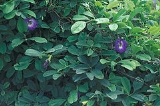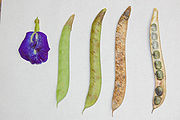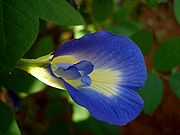
Clitoria ternatea
Encyclopedia
Clitoria ternateais a plant species belonging to the Fabaceae
family.
_i_img_9809.jpg) It is a perennial herbaceous plant. Its leaves are elliptic and obtuse. It grows as a vine or creeper, doing well in moist neutral soil.
It is a perennial herbaceous plant. Its leaves are elliptic and obtuse. It grows as a vine or creeper, doing well in moist neutral soil.
The most striking feature about this plant are its vivid deep blue flowers. They are solitary, with light yellow markings. They are about 4 cm long by 3 cm wide. There are some varieties that yield white flowers.
The fruits are 5 – 7 cm long, flat pods with 6 to 10 seeds in each pod. They are edible when tender.
It is grown as an ornamental plant and as a revegetation species (e.g., in coal mines in Australia), requiring little care when cultivated. Its roots fix nitrogen and therefore this plant is also used to improve soil quality.
 In Southeast Asia the flowers are used to colour food. In Malay cooking, an aqueous extract is used to colour glutinous rice for kuih ketan (also known as pulut tai tai in Peranakan/Nyonya cooking) and in nonya chang. In Thailand, a syrupy blue drink is made called nam dok anchan (น้ำดอกอัญชัน). In Burma the flowers are used as food, often they are dipped in batter and fried.
In Southeast Asia the flowers are used to colour food. In Malay cooking, an aqueous extract is used to colour glutinous rice for kuih ketan (also known as pulut tai tai in Peranakan/Nyonya cooking) and in nonya chang. In Thailand, a syrupy blue drink is made called nam dok anchan (น้ำดอกอัญชัน). In Burma the flowers are used as food, often they are dipped in batter and fried.
In animal tests the methanolic extract of Clitoria ternatea roots demonstrated nootropic
, anxiolytic
, antidepressant
, anticonvulsant
and antistress activity. The active constituent(s) include Tannins, resins, Starch, Taraxerol & Taraxerone.
Clitoria ternatea root extracts are capable of curing whooping cough if taken orally. The extract from the white-flowered plant can cure goiter. The roots are used in ayurveda
Indian medicine.
Recently, several biologically active peptides called cliotides have been isolated from the heat-stable fraction of Clitoria ternatea extract. Cliotides belong to the cyclotides family and acvities studies show that cliotides display potent antimicrobial activity against E. coli, K. pneumonia, P. aeruginosa and cytotoxicity against HeLa cells. These peptides have potential to be lead compound for the development of novel antimicrobial and anti-cancer agents.
 The flowers of this vine have the shape of human female pudenda
The flowers of this vine have the shape of human female pudenda
, hence the Latin
name of the genus
"Clitoria
", from "clitoris
". (Synonyms: Clitoris principissae.) "Ternatea", the name of the species, comes from Ternate
, a location in Indonesia
. In some languages (Tamil
, Malayalam) it is named after the seashell, which is a euphemism for a woman's external sexual organs..
The sinhala name seems to be free of such connotations.
Owing to its similarity to a human body part, this plant has been ascribed properties affecting the same (a phenomenon also found in connection with the mandrake
, among other plants). It was used traditionally to cure sexual ailments, like infertility and gonorrhea, to control menstrual discharge, and also as an aphrodisiac
. This practice is rooted in an ancient belief recorded in the Doctrine of Signatures
.
Some common names are: (Sankhupushpam) (Gokarna)
Fabaceae
The Fabaceae or Leguminosae, commonly known as the legume, pea, or bean family, is a large and economically important family of flowering plants. The group is the third largest land plant family, behind only the Orchidaceae and Asteraceae, with 730 genera and over 19,400 species...
family.
Distribution
This plant is native to tropical equatorial Asia, but has been introduced to Africa, Australia and America.Description
_i_img_9809.jpg)
The most striking feature about this plant are its vivid deep blue flowers. They are solitary, with light yellow markings. They are about 4 cm long by 3 cm wide. There are some varieties that yield white flowers.
The fruits are 5 – 7 cm long, flat pods with 6 to 10 seeds in each pod. They are edible when tender.
It is grown as an ornamental plant and as a revegetation species (e.g., in coal mines in Australia), requiring little care when cultivated. Its roots fix nitrogen and therefore this plant is also used to improve soil quality.
Uses
In traditional Ayurvedic medicine, it has been used for centuries as a memory enhancer, nootropic, antistress, anxiolytic, antidepressant, anticonvulsant, tranquilizing and sedative agent.
In animal tests the methanolic extract of Clitoria ternatea roots demonstrated nootropic
Nootropic
Nootropics , also referred to as smart drugs, brain steroids, memory enhancers, cognitive enhancers, and intelligence enhancers, are drugs, supplements, nutraceuticals, and functional foods that improve mental functions such as cognition, memory, intelligence, motivation, attention, and concentration...
, anxiolytic
Anxiolytic
An anxiolytic is a drug used for the treatment of anxiety, and its related psychological and physical symptoms...
, antidepressant
Antidepressant
An antidepressant is a psychiatric medication used to alleviate mood disorders, such as major depression and dysthymia and anxiety disorders such as social anxiety disorder. According to Gelder, Mayou &*Geddes people with a depressive illness will experience a therapeutic effect to their mood;...
, anticonvulsant
Anticonvulsant
The anticonvulsants are a diverse group of pharmaceuticals used in the treatment of epileptic seizures. Anticonvulsants are also increasingly being used in the treatment of bipolar disorder, since many seem to act as mood stabilizers, and in the treatment of neuropathic pain. The goal of an...
and antistress activity. The active constituent(s) include Tannins, resins, Starch, Taraxerol & Taraxerone.
Clitoria ternatea root extracts are capable of curing whooping cough if taken orally. The extract from the white-flowered plant can cure goiter. The roots are used in ayurveda
Ayurveda
Ayurveda or ayurvedic medicine is a system of traditional medicine native to India and a form of alternative medicine. In Sanskrit, words , meaning "longevity", and , meaning "knowledge" or "science". The earliest literature on Indian medical practice appeared during the Vedic period in India,...
Indian medicine.
Recently, several biologically active peptides called cliotides have been isolated from the heat-stable fraction of Clitoria ternatea extract. Cliotides belong to the cyclotides family and acvities studies show that cliotides display potent antimicrobial activity against E. coli, K. pneumonia, P. aeruginosa and cytotoxicity against HeLa cells. These peptides have potential to be lead compound for the development of novel antimicrobial and anti-cancer agents.
Names

Vulva
The vulva consists of the external genital organs of the female mammal. This article deals with the vulva of the human being, although the structures are similar for other mammals....
, hence the Latin
Latin
Latin is an Italic language originally spoken in Latium and Ancient Rome. It, along with most European languages, is a descendant of the ancient Proto-Indo-European language. Although it is considered a dead language, a number of scholars and members of the Christian clergy speak it fluently, and...
name of the genus
Genus
In biology, a genus is a low-level taxonomic rank used in the biological classification of living and fossil organisms, which is an example of definition by genus and differentia...
"Clitoria
Clitoria
Clitoria is a genus of flowering plants that are insect pollinated.-Distribution and uses:These plants are native to tropical and temperate areas of the Old World....
", from "clitoris
Clitoris
The clitoris is a sexual organ that is present only in female mammals. In humans, the visible button-like portion is located near the anterior junction of the labia minora, above the opening of the urethra and vagina. Unlike the penis, which is homologous to the clitoris, the clitoris does not...
". (Synonyms: Clitoris principissae.) "Ternatea", the name of the species, comes from Ternate
Ternate
Ternate is an island in the Maluku Islands of eastern Indonesia. It is located off the west coast of the larger island of Halmahera, the center of the powerful former Sultanate of Ternate....
, a location in Indonesia
Indonesia
Indonesia , officially the Republic of Indonesia , is a country in Southeast Asia and Oceania. Indonesia is an archipelago comprising approximately 13,000 islands. It has 33 provinces with over 238 million people, and is the world's fourth most populous country. Indonesia is a republic, with an...
. In some languages (Tamil
Tamil language
Tamil is a Dravidian language spoken predominantly by Tamil people of the Indian subcontinent. It has official status in the Indian state of Tamil Nadu and in the Indian union territory of Pondicherry. Tamil is also an official language of Sri Lanka and Singapore...
, Malayalam) it is named after the seashell, which is a euphemism for a woman's external sexual organs..
The sinhala name seems to be free of such connotations.
Owing to its similarity to a human body part, this plant has been ascribed properties affecting the same (a phenomenon also found in connection with the mandrake
Mandrake (plant)
Mandrake is the common name for members of the plant genus Mandragora, particularly the species Mandragora officinarum, belonging to the nightshades family...
, among other plants). It was used traditionally to cure sexual ailments, like infertility and gonorrhea, to control menstrual discharge, and also as an aphrodisiac
Aphrodisiac
An aphrodisiac is a substance that increases sexual desire. The name comes from Aphrodite, the Greek goddess of sexuality and love. Throughout history, many foods, drinks, and behaviors have had a reputation for making sex more attainable and/or pleasurable...
. This practice is rooted in an ancient belief recorded in the Doctrine of Signatures
Doctrine of signatures
The doctrine of signatures is a philosophy shared by herbalists from the time of Dioscurides and Galen. This doctrine states that herbs that resemble various parts of the body can be used to treat ailments of that part of the body. Examples include the plants liverwort; snakeroot, an antidote for...
.
Some common names are: (Sankhupushpam) (Gokarna)
- Sanskrit: aparajita (अपराजिता), saukarnika , ardrakarni, girikarnika (गिरिकर्णिका), supuspi (सुपुष्पी), mohanasini (मोह्नाशिनी), vishadoshaghni (विषदोषघ्नी), shwetanama (श्वेतनामा)., Vishnukranta (विष्णुक्रांता), ashwakhura (अश्वखुरा)} (dok anchan)
- Bahasa Indonesia: Bunga telang, bunga teleng, bunga biru-Sri Lanka: "Katarodu" ("කටරොඩු") or "katarolu" or ("කටරොලු") (normally specify with colour "නිල් " ("Nil") for blue or purple and "සුදු" ("Sudu") for white)(phaka Amatak)

